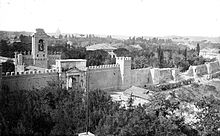Roman question
| Papal States (1870–1929) | |||||
|---|---|---|---|---|---|
|
|||||
|
|||||
| Official language | Latin , Italian | ||||
| Capital | Vatican | ||||
| Form of government | absolute elective monarchy | ||||
| Head of State and Government | Pope , most recently Pius XI. | ||||
The Roman question describes the conflict over the status of the area around the city of Rome or the territory of the Vatican , the power center of the Catholic Church . Until 1870 the Papal States was an independent area and not yet part of the Kingdom of Italy , which was founded in 1861. Italy wanted to take over the area, which was prevented by the presence of French troops.
The area de jure had been part of Italy since 1870 , but it remained unclear what status the Vatican should have. In practice it was a de facto regime . On February 11, 1929, this conflict was resolved with the Lateran Treaty: The fascist government of Italy under Mussolini guaranteed the Vatican as Vatican City political independence and full state sovereignty , while the Catholic Church recognized Rome as the capital of Italy.
Roman question before 1870
The Italian unification movement of the Risorgimento (= resurrection), which was liberal in the 19th century and which had appeared in the various principalities and monarchies of the Apennine Peninsula and had set itself the goal of creating an Italian nation-state , had been following the demand since the 1830s a secular rule over Rome . Rome was viewed by the Italian nationalists as the natural capital of Italy, but the establishment of a revolutionary Roman republic failed in 1849 due to military intervention by France and Spain. Both powers guaranteed the sovereignty of the papal state .
A part of the Papal States, the Romagna , the Marches and Umbria was, yet according to various revolutionary upheavals and armed conflicts in 1860 to the Kingdom of Sardinia like that since the European revolutions of 1848-49 under King Charles Albert and his successor Victor Emmanuel II. For Had become the pioneering state of the Italian unity movement.
After these successes of the Piedmontese troops and republican irregular units (e.g. under Giuseppe Garibaldi ), the new Italian nation-state was proclaimed as a constitutional monarchy under Victor Emanuel II and its first prime minister, Camillo Benso von Cavour . Its capital was initially moved from Turin to Florence . In October 1867 Garibaldi tried with a few troops to take Rome. However, his units were defeated by papal and French troops on November 3, 1867.
Emperor Napoleon III. from France was under domestic political pressure; his protection for the Pope earned him the enthusiasm of many conservative Catholics across Europe. Austria, on the other hand, traditionally also friendly to the Pope, would have come to terms with an annexation of Rome by Italy. The unresolved Roman question was an important reason why Italy did not want to join an Austro-French alliance at the time .

The outbreak of war between France and the German states on July 19, 1870, helped Italy over the question of the Papal States . After France withdrew its protective troops from Rome as a result of this war, Italian troops conquered the Papal States on September 11, 1870, without encountering any resistance worth mentioning. On September 20, 1870, Rome was taken - with purely symbolic resistance and subsequent surrender of the papal army.
Status of the Vatican after 1870

A referendum resulted in broad support for the unification of the Papal States with Italy. The association was proclaimed by royal decree on October 6, 1870. Thus the unification of Italy and with it the aim of the Risorgimento was completed. In 1871 the Italian capital was moved from Florence to Rome. Most foreign states also moved their embassies to Rome, thereby tacitly recognizing the end of the secular rule of the papacy.
The Pope continued to have his seat in the Vatican . In the so-called guarantee laws of May 1871, his position in the Italian capital was regulated - albeit initially only unilaterally from the Italian government. Accordingly, the Vatican, the Lateran and the papal summer residence in Castel Gandolfo remained under the sovereignty of the Pope.
Pius IX and his immediate successor Leo XIII. and Pius X , however, did not recognize both the legal regulations for the Vatican and the new Italy and refused any official diplomatic cooperation with the new rulers, so that the dispute over the status of the Catholic Church and the initially not formally regulated independent state independence of the Vatican, even after the completion of Italian unity, a long-simmering conflict in the new Italy remained - the so-called Roman question . Pius IX considered himself a " prisoner in the Vatican ". He banned the authors and participants in the taking of the Papal States . In the papal bull Non expedit of September 10, 1874, he forbade Italian Catholics to participate actively and passively in democratic elections in Italy under threat of deprivation of church privileges.
His demand for the restoration of the secular power of the papacy remained unsuccessful, however - despite the continued existence of the Church's supremacy, which has also increased political influence since the proclamation of the papal infallibility after the First Vatican Council on July 18, 1870. Wide Catholic classes remained alienated by the capture of Rome. During the First World War , considerations were made to provide the Holy See with a sovereign territorial base in order to strengthen its negotiating base with the Kingdom of Italy - it was not initially intended that the Pope would leave Rome. These considerations were directed towards different territories such as Friuli with the capital Udine , Elba , an Adriatic island or Liechtenstein , but remained without result. It was not until the Lateran Treaty concluded in 1929 between Pope Pius XI. or his authorized representative Pietro Gasparri and the Kingdom of Italy ruled by the fascist government of Italy under Benito Mussolini , in which the Holy See recognized Rome as the capital and seat of the Italian government, the political and state sovereignty of the Vatican was guaranteed by Italy and thus formally approved.
Individual evidence
- ^ Heinrich Lutz : Foreign policy tendencies of the Habsburg monarchy from 1866 to 1870: "Re-entry in Germany" and consolidation as a European power in the alliance with France. In: Eberhard Kolb (Hrsg.): Europe before the war of 1870. Power constellation - areas of conflict - outbreak of war. R. Oldenbourg, Munich 1987, pp. 1-16, here p. 10.
- ↑ a b The Pope as Prince of Liechtenstein? , in: NZZ of March 7, 2016
- ↑ NZZ of February 1, 1922: https://static.nzz.ch/files/8/7/3/Liechtenstein+NZZ+1_1.18707873.2_1.18707873.1922+R%c3%b6mische+Frage_1.18707873.pdf
literature
- Stefan Gatzhammer : Proposals for solving the "Quaestio Romana" in relation to papal sovereignty from 1848 to 1928. Available at http://opus.kobv.de/ubp/volltexte/2009/2922/ (publication server of the University of Potsdam)
- Luigi Monzo: croci e fasci - Italian church construction in the time of fascism, 1919–1945. 2 vol. Karlsruhe 2017 (dissertation, Karlsruhe Institute of Technology, 2017), pp. 63–91.
- Gustav Seibt : Rome or Death. The fight for the Italian capital. Siedler-Verlag , Berlin 2001, 352 pages (online reviews of the book in taz No. 6587 of October 30, 2001 and in der Welt of May 11, 2002 )
- Francesco Traniello : Catholicism and Political Culture in Italy. Aschendorff Verlag , Münster 2016.
- Stefan Heid , Karl-Joseph Hummel (ed.): Papality and patriotism. The Campo Santo Teutonico: Place of the Germans in Rome between Risorgimento and the First World War (1870–1918) (= Roman quarterly for Christian antiquity and church history . Supplement vol. 65). Herder, Freiburg (Breisgau) et al. 2018, ISBN 978-3-451-38130-0 .
Web links
- The Vatican - State of Priests with a section on the Roman question (planet-wissen.de)
- Article in Die Tagespost - Catholic newspaper for politics, society and culture on the 75th anniversary of the constitution of Vatican City / the adoption of the Lateran Treaty
- Text of the Lateran Pacts (English)


